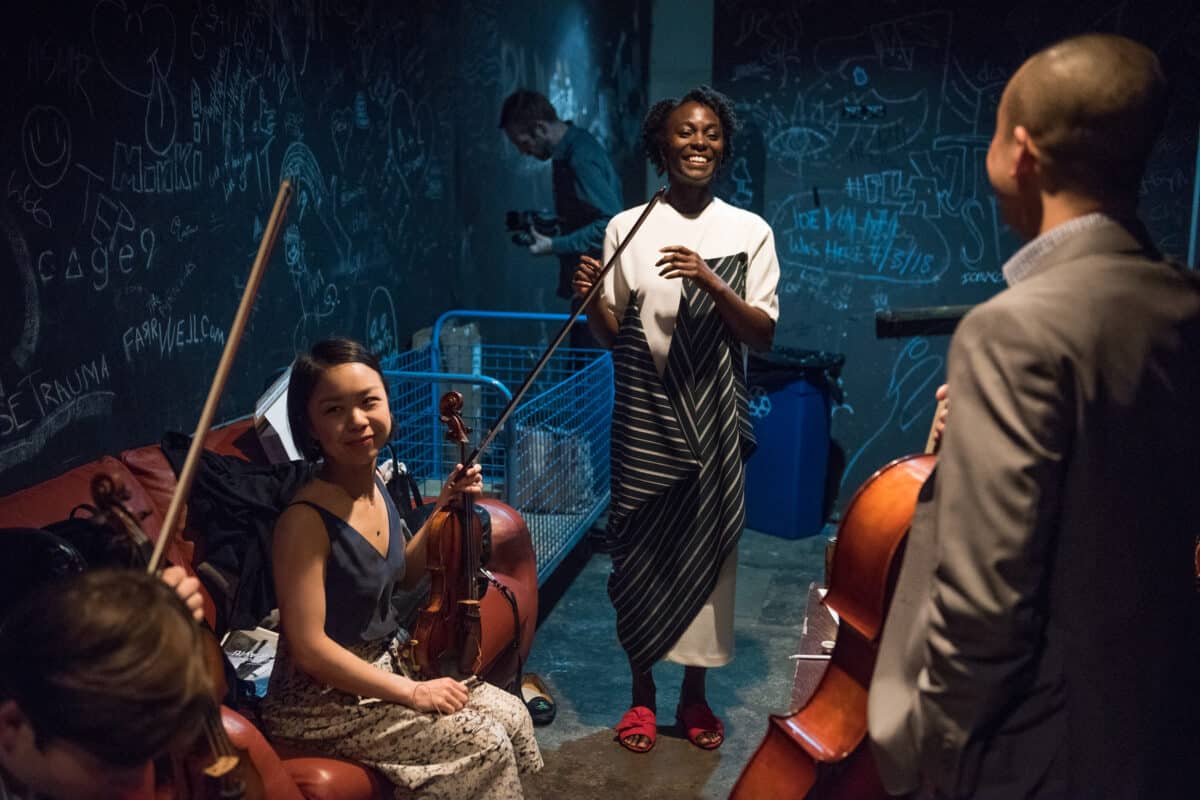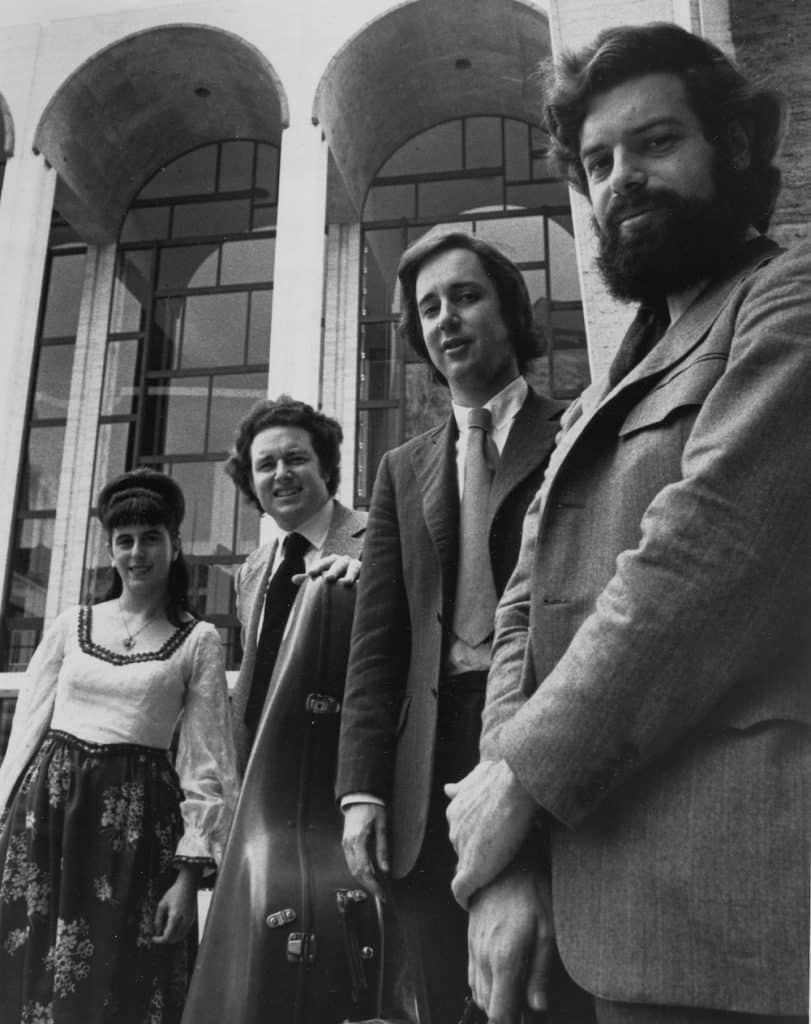Word Travels
Nathalie Joachim tells the story of Haiti through the songs of its women.

Nathalie Joachim’s Fanm d’Ayiti manages to be both intimate and international at the same time. The song cycle, arranged for string quartet, voice, flute, and electronics, weaves together the most personal of anecdotes from the composer’s life with popular tunes from Haiti’s deep folkloric traditions.
The work lasts just 90 minutes, but it is sweeping—in French, Haitian Creole, and English, and spanning a century of cultural history. It features the high-tech of audio recordings collected through field research and the pre-tech of Joachim’s own voice and flute. Yet, it plays out like a private conversation, a storytelling session set to music.
That’s by necessity as much by design. For Joachim, recounting the art of some of Haiti’s great female singers expanded naturally to include stories about the women in her own family. They are all Fanm d’Ayiti—which translates to Women of Haiti—linked together like the music that has flowed through their lives.
“For me, it was impossible to remove myself from this story,” said Joachim. “It’s a piece of my identity that I take great pride in.”
Fanm d’Ayiti is a departure for Joachim, primarily a flutist, who graduated from the Juilliard School and is known for her work with the contemporary chamber music ensemble Eighth Blackbird and the self-described “urban art pop duo” Flutronix.
While her compositional work varies, it is not typically as narrative-driven as Fanm d’Ayiti, which premiered in March as part of the Saint Paul Chamber Orchestra’s contemporary Liquid Music Series.
But the project became a mission for her, and almost by accident. Joachim was born in Brooklyn to Haitian parents and traveled often to Haiti as a child to spend time with relatives. One day, she was talking to her parents about the role of Haitian women in popular music. Of all the women out there, who were their favorites, who did they find memorable?
“They couldn’t really think of more than a dozen women, which was in direct conflict to my personal experience of the music in my family,” she said.
Her home was full of singing growing up: her mother singing while cooking and cleaning the house; her grandmother teaching her songs; and the two of them making up new ones together—her first real experiences with composition. “Culturally, music was always a very important and present thing,” she said.
Haiti has had its share of female vocalists, but somehow men—as soloists and in bands both large and small—have dominated the popular imagination. One day, she thought, she would explore that tension.
Of course, that happened sooner than she thought.

Just a little more than two years ago, Liquid Music’s curator Kate Nordstrum reached out to Joachim about the possibility of contributing a new piece to her adventurous series. Nordstrum had seen the flutist perform with Eighth Blackbird and was intrigued by what she might write, imagining she might compose something new for the ensemble to premiere as part of the series.
Joachim sent a wishlist of possibilities. At the very bottom were some rough notes about Haitian music and women. “I wasn’t even sure what it might end up being,” said Joachim.
Nordstrum immediately saw the possibilities. “It was the last idea that she threw out, but it was clearly the most personal.”
It also fit into Liquid Music’s new “virtual residency” program, a two-year connection to artists that allows them to do research for one year, then prepare a piece for an open slot the following season.
Instead of camping out in Minnesota, composers travel and blog about their experiences. The blogs are public, giving audiences a chance to see how the compositional process unfolds. “This was a perfect project for that,” said Nordstrum. “We needed more time [to present it], and she needed support.”







Liquid Music used it connections to help enlist funders. All told, the project received travel, logistical, and performance support from the Jerome Foundation, New Music USA, and the Chauncey and Marion Deering McCormick Foundation.
And Joachim turned the blog posts into an enthralling travelogue. Her entries are personal, rich in historical detail, and often funny.
About taking a bus from Port-au-Prince to her family’s small town of Dantan:
“When I saw my luggage ascend to the top of this vehicle to be tied down with some rope, I think I actually swallowed a squeal and internally thanked every item in my suitcase for its service.”
On the complex roots of the Yanvalou musical tradition, practiced by Haitian slaves from West Africa:
“This music represents a long history of storytelling, spirituality, social commentary and survival. Yanvalou music is to Haiti as the Negro spiritual is to America—more than songs, they are a means of communicating, both subtly and overtly. That music was essential to the preservation of the culture of black people and thus their survival.”
“She naturally shares what she’s learning and how she’s feeling,” said Nordstrum. “It was a beautiful thing to realize.”
That skill, Nordstrum believes, manifested itself in the actual performance. When Joachim put it all together, “the audience was clinging to her every word. Because along with this beautiful music, was this history and interesting characters and the voices of these women.”
Joachim approached the project like an anthropologist, examining social history, surveying a wide range of recordings, talking to musicians, academics, family, and friends, anyone she could meet who was familiar with the history of the music. The goal was to find the right source material to expand into her new composition.
“For me, the bulk of this project was really about research,” said Joachim. “It wasn’t until I got down to writing that I decided on the songs.”
Eventually, she chose to reinterpret the work of three singers whose careers resonated widely. The easy pick was the popular artist Toto Bissainthe, who Joachim describes as “such an inspiration for me in this project, and in life.” That was rounded out by two other influential names: Emerante de Pradines and Carole Demesmin.
Joachim sought them out.
She learned that de Pradines, a singer, dancer, and the daughter of the legendary musician August de Pradines, was running a music school in a “very, very remote village” in Haiti. She was able to visit the singer shortly before she died in January of this year, at the age of ninety-nine.
She visited Demesmin in Miami, where she is living as she continues a decades-long career of singing, teaching, organizing music festivals, and tirelessly advocating for the well-being of people in her home country.
Bissainthe died in 1994, but Joachim spent time with her daughter, Milena Sandler, who runs a radio station and organizes a jazz festival in Port-au-Prince. Sandler talked about her mother’s career as an actress, singer, and social activist who never felt that she got the recognition she deserved. On the blog, Joachim wrote: “To hear her speak of her mother was enthralling. And like her mother, her big doe eyes gave away every emotion: excitement, wonder, respect.“
Among the many topics in Joachim’s interviews, she asked about influences and legacies. Turns out, the women were familiar with one another’s art. The musical world of women in Haiti became surprisingly small. “Funny how all of their careers influenced each other,” said Joachim.

Joachim arranged the songs for Fanm d’Ayiti with a free hand. She preserves melodies and emotions but lets the songs drift into dreamier worlds. She chose to use a string quartet because of its sonic versatility. “I knew I had to have an ensemble with texture flexibility, and one that could really support a range of styles,” she said.
Then she added electronics and other sound elements from her personal toolbox as a composer and producer. Joachim has a history of incorporating theater, dance, and technology into her work. As part of her graduate studies at The New School, she focused on audio production and sound design.
While she was in Haiti researching, she attended a church service with her family. Her father suggested she bring along a recorder in case she wanted to collect sounds. The service featured a choir of girls accompanied by a man playing conga drums.
The moment emerged as “a turning point for the project.” It was a Christian mass, delivered in Haitian Creole, and tapping African music traditions. Joachim knew this intersection of cultures was key to what she wanted to explore. The Girls Choir of Ecole Presbyteral Fatima de Dantan in turn became an integral part of Fanm d’Ayiti.
She had one audio resource left, a recording she had made of her own grandmother, Ipheta Fortuma, just before she passed away a few years ago. “I recorded her to really just have her voice for myself—she was 96 at the time. I never intended to use it for any other purpose.”
But incorporating the voice of the woman who taught her influential folkloric songs, and in turn laid the foundation for her enduring passion for music, was a natural move.
Adding the electronics allowed the music to cross into another world, that of contemporary classical music, where the sonic palate has become endlessly broad. That brought legitimacy, Joachim believes, to a present-day Haitian-American dabbling into the culture of the past. “I didn’t want it to sound like a parody of Haitian songs. I didn’t want to feel like I was appropriating a style of music because I had access to it.”
As a work of art, Fanm d’Ayiti promises to live on. Joachim is now touring the piece and lining up performances near and far. She recently received funding to record it.
Exposure to the work, she hopes, will gives listeners a richer understanding of Haiti, a complex nation whose image is dominated by media coverage that focuses on the negative—poverty, poor health care, and natural disasters, such as Hurricane Matthew, which caused catastrophic damage in 2016.
“It’s easy to get wrapped up in what gets reported,” she said. “But beautiful things happen there.”
Joachim also found a deep well of inspiration in the activist history of her subjects, with particular resonance in our current political moment. Toto Bissainthe, who used her music to speak out against the totalitarian regimes of François and Jean Claude Duvalier, spent much of her career in exile, but remained a vocal advocate for Haiti abroad. Her work, and that of her peers, offered a powerful model.
“In their own way, they were using their voices to uplift the people of Haiti,” Joachim said.
Fanm d’Ayiti will no doubt teach listeners a lot about Haiti, its history, politics, and music. But they will also learn plenty about its composer.
“At the end of the day, the score had to really reflect me as an artist,” she said.
“It’s totally Haiti, and it’s totally me.”



